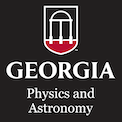Events Calendar View
-
CSP Lunch Seminar
Nov 29, 2016
Improving Lattice Models for Protein Folding: Crambin as a Case Study
-
Departmental Colloquium
Dec 1, 2016
High Quality Computation of Selective Atomic and Molecular Processes
Photoionization of atomic and molecular species is an important process in determining the ionization balance and hence the abundances of elements in astrophysical nebulae. It has recently become possible to detect neutron-capture elements (atomic number Z>30) in a large number of ionized nebulae. Accurate assessment of elemental abundances in astrophysical nebulae can be made from the direct comparison of the observed spectra with synthetic non-local thermodynamic equilibrium (NLTE) spectra, if the atomic data for electron and photon interaction processes are known with sufficient accuracy. Experiments on light systems, trans-Fe elements and molecules at third generation synchrotron radiation source, such the Advanced Light Source (ALS) in Berkeley, California, USA, SOLEIL in Saint-Aubin, France, ASTRID II in Aarhus, Denmark and PETRA III, in Hamburg, Germany, require high quality theoretical studies to interpret experimental results. Results will be presented from recently developed ab initio R-matrix methods for atomic and molecular systems using parallel computing architectures. Photoionization cross sections will be presented for a variety of atomic species; Se, Kr, Ar, Xe, W, Si, S, Cl, C, N, and O, in neutral or low stages of ionization. Comparison of our theoretical results with experiments performed at leading synchrotron light sources serve as the ultimate benchmark for theory, in order to have confidence in the atomic and molecular data being incorporated into astrophysical modelling codes such as CLOUDY, XSTAR, CHIANTI and ATOMDB. -
Observatory Open House
Dec 2, 2016
Observatory Viewing
We will be having another public viewing on December 2, 2016. Because of the limited space in the dome, you must have a reservation to come to this showing. Click here to make a reservation.
The observatory is located at the top of the Physics building. To get to the observatory take the elevator to the 4th floor. A guide will meet you on the 4th floor and direct your group to the stairway that leads to the observatory. As the weather can be unpredictable, we might not know whether a viewing will be possible until shortly before the event begins.
If you need more information please call 706-542-2485.
-
Boyd Lecture Series
Jan 12, 2017
Last Tango in Space: Detecting Gravitational Waves from Binary Black Hole Mergers for the First Time Ever Using LIGO
The first direct detections of gravitational waves in late 2015 were made possible by a forty year experimental campaign to design, build, andoperate LIGO, the Laser Interferometer Gravitational-wave Observatory. In this talk, I will cover gravitational waves and what makes them so difficult to detect and at the same time such powerful and unique probes of the universe. Most of the presentation will focus on the interferometers, the LIGO detections and their astrophysical implications. Time permitting, I will give a preview of where LIGO intends to go in the next decade and beyond. -
Departmental Colloquium
Jan 19, 2017
The Dark Side of H2 in the Galaxy: The Empire Strikes Back
The idea that substantial molecular gas is present in the interstellar medium but is not detectable by the CO(1-0) emission line has become fairly prevalent in the last decade. This component hasbecome known as "dark gas", a term first suggested in a paper describing its properties and extent by Grenier, Casandjian and Terrier (2005). Their main conclusion is that the dark gas mass in the Milky Way is comparable to the molecular mass detected by CO(1-0) emission. More recent studies seem to corroborate this conclusion. A key element in deciding whether molecular gas may be dark or not depends on thesensitivity of the CO observations. Here we present very sensitive CO, OH, and CH observations of the outer regions of diffuse molecular gas which show that most of the dark molecular gas can be spectroscopically detected with sensitive enough observations. -
Departmental Colloquium
Jan 26, 2017
Molecular Astrophysics: Cool Stars and Exoplanets
The spectra of "cool" astronomical objects such as low mass stars, brown dwarfs and exoplanets are dominated by molecular absorption features. Of particular interest are methane, water, ammonia and diatomic hydrides at high temperatures. An overview of this area of molecular astronomy will be presented from a spectroscopic perspective. The talk will include emission and absorption laboratory measurements of hot molecules by Fourier transform spectroscopy as related to exoplanets.
Page 70 of 121, showing 6 records out of 723 total, starting on record 415, ending on 420


